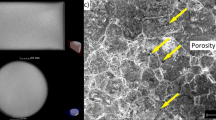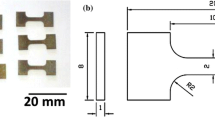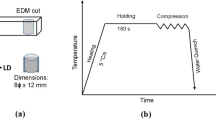Abstract
The objective of the present work is to characterize the influence of cold work on the thermoelastic martensitic transformation and on the apparent elastic modulus of the Ni-free Ti-21.6Hf-23.7Nb-1Zr alloy in order to determine the key factor that promotes the desired shape memory properties and/or low apparent elastic modulus. A vacuum arc melted button of each alloy was heat treated at 1100 °C during 1.5 h and quenched with a mixture of ethanol/water at 0 °C. Samples of the alloy were cold rolled from 5% up to 95% and, finally, microstructurally and mechanically characterized. The apparent elastic modulus for each condition as well as the reversibility percentages were evaluated by instrumented nanoindentation using a Berkovich tip and a spherical tip, respectively. A higher proportion of martensite was found in the low cold work percentages compared to the untreated material as it was observed by optical and TEM microscopy. A decrease in the apparent elastic modulus was observed when increasing the cold work percentage. The lowest value was found in the 99% cold work condition with 44 GPa, value closer to that of cortical bone. Cyclic nanoindentation tests show an increase in the reversibility percentages in the cold worked condition compared to the untreated material.









Similar content being viewed by others
References
T.W. Duering, K.N. Melton, D. Stoeckel and C.M. Wayman Engineering aspects of shape memory alloys. Butterworth-Heinemann Ltd., 1990.
T. Saito, T. Furuta, J.H. Hwang, S. Kuramoto, K. Nishino, N. Suzuki, R. Cheng, A. Yamada, K. Ito, Y. Seno, T. Nonaka, H. Ikehata, N. Nagasako, C. Iwamoto, Y. Ikuhara and T. Sakuma. Multifunctional Alloys Obtained via a Dislocation-Free Plastic Deformation Mechanism. Science 2003;300, p 464–467.
Y.L. Hao, Titanium Alloy with Extra-Low Modulus and Superelasticity and its Producing Method and Processing Thereof, US 2007/0137742 A1, 2007
M. Niinomi. Recent research and development in titanium alloys for biomedical applications and healthcare goods. Science and Technology of Advanced Materials 2003; 4(5):445–454.
.L. Hao, S.J. Li, S.Y. Sun, C.Y. Zheng and R. Yang. Elastic deformation behaviour of Ti-24Nb-4Zr-7.9Sn for biomedical applications. Acta Biomaterialia 2007; 3(2), p 277–286.
A.C.Fischer-Cripps. Nanoindentation. 2nd ed. Springer, 2004.
W. Yan, Q. Sun and H.Y. Liu. Spherical indentation hardness of shape memory alloys. Materials Science and Engineering: A 2006; 425(1–2), p 278-285.
C.P. Frick, T.W. Lang, K. Spark and K. Gall. Stress-induced martensitic transformations and shape memory at nanometer scales. Acta Materialia 2006; 54(8), p 2223–2234.
T. Juliano, Y. Gogotsi and V. Domnich. Effect of indentation unloading conditions on phase transformation induced events in silicon. J Mater Res, 2003; 18(5), p 1192–1201.
Y. Liu, H. Xiang. Apparent modulus of elasticity of near-equiatomic NiTi. Journal of Alloys and Compounds 1998; 270(1–2):154–159.
M. Arciniegas, J.M. Manero, J. Peña, F.J. Gil and J.A. Planell. Study of New Multifunctional Shape Memory and Low Elastic Modulus Ni-Free Ti Alloys. Metallurgical and Materials Transactions A 2008; 39(4), p 742–751.
G.M. Pharr. Measurement of mechanical properties by ultra-low load indentation. Materials Science and Engineering A 1998; 253(1–2), p 151–159.
W. Yan, Q. Sun, F. Xi-Qiao and L. Qian. Analysis of spherical indentation of superelastic shape memory alloys. International Journal of Solids and Structures 2007; 44(1), p 1–17.
A.C. Fischer-Cripps. A review of analysis methods for sub-micron indentation testing. Vacuum 2000; 58(4), p 569–585.
J. Hwang, S. Kuramoto, T. Furuta, K. Nishino and T. Saito. Phase-stability dependence of plastic deformation behavior in Ti-Nb-Ta-Zr-O alloys. Journal of Materials Engineering and Performance 2005; 14(6), p 747–754.
Y.L. Hao, S.J. Li, Y. Sun, C.Y. Zheng, Q.M. Hu, and R. Yang, Super-Elastic Titanium Alloy with Unstable Plastic Deformation, Appl. Phys. Lett., 2005, p 87
J. Schiøtz, F.D. Di Tolla and K.W. Jacobsen. Softening of nanocrystalline metals at very small grain sizes. Nature 1998; 391, p 561563.
Acknowledgments
This work was carried out with the support of the Generalitat de Catalunya Commission for the Universities and Research of the Department of Innovation, Universities and Companies and the European Social Fund.
Author information
Authors and Affiliations
Corresponding author
Additional information
This article is an invited paper selected from presentations at Shape Memory and Superelastic Technologies 2008, held September 21-25, 2008, in Stresa, Italy, and has been expanded from the original presentation.
Rights and permissions
About this article
Cite this article
González, M., Peña, J., Manero, J.M. et al. Optimization of the Ti-16.2Hf-24.8Nb-1Zr Alloy by Cold Working. J. of Materi Eng and Perform 18, 506–510 (2009). https://doi.org/10.1007/s11665-009-9393-y
Received:
Revised:
Accepted:
Published:
Issue Date:
DOI: https://doi.org/10.1007/s11665-009-9393-y




